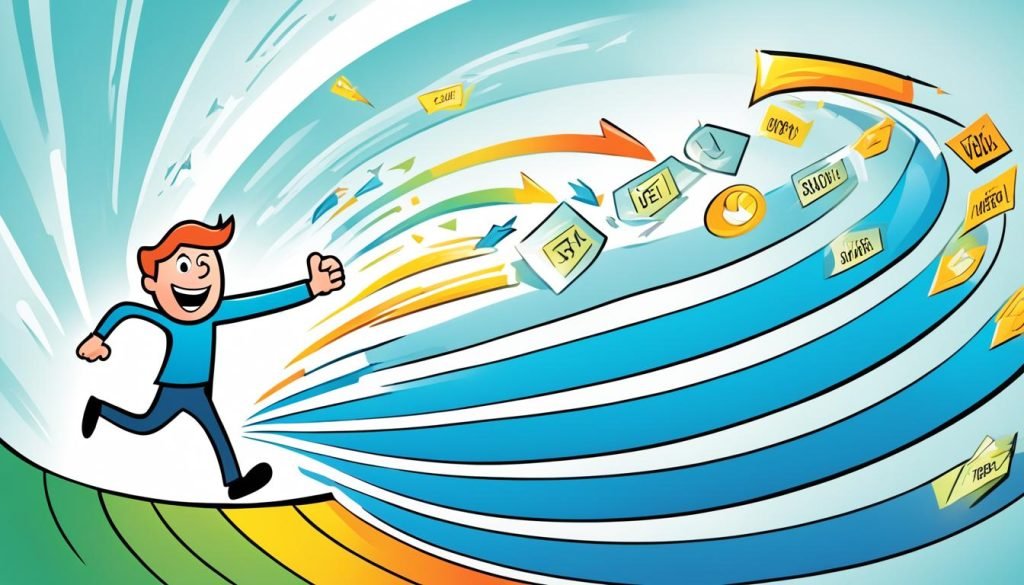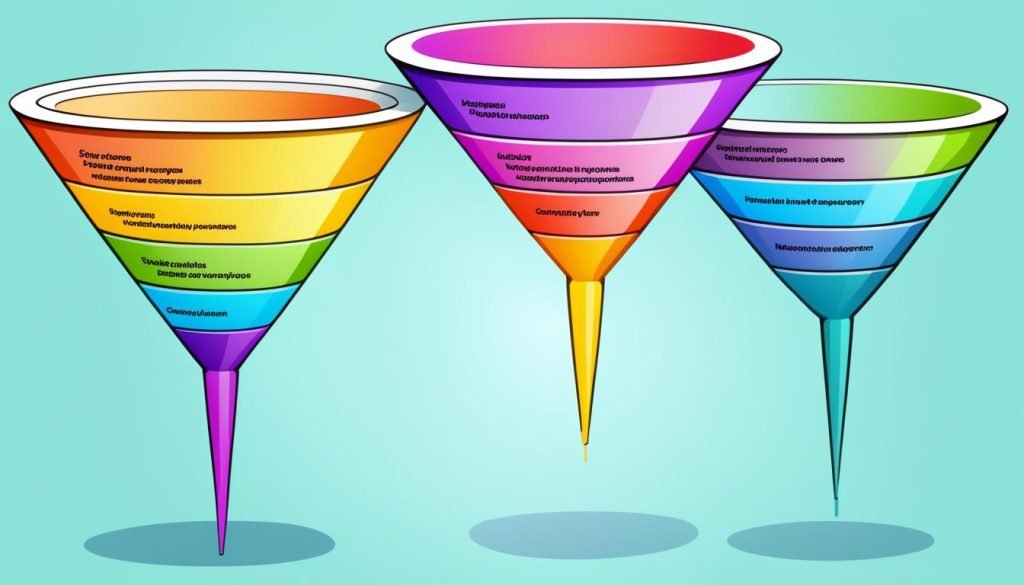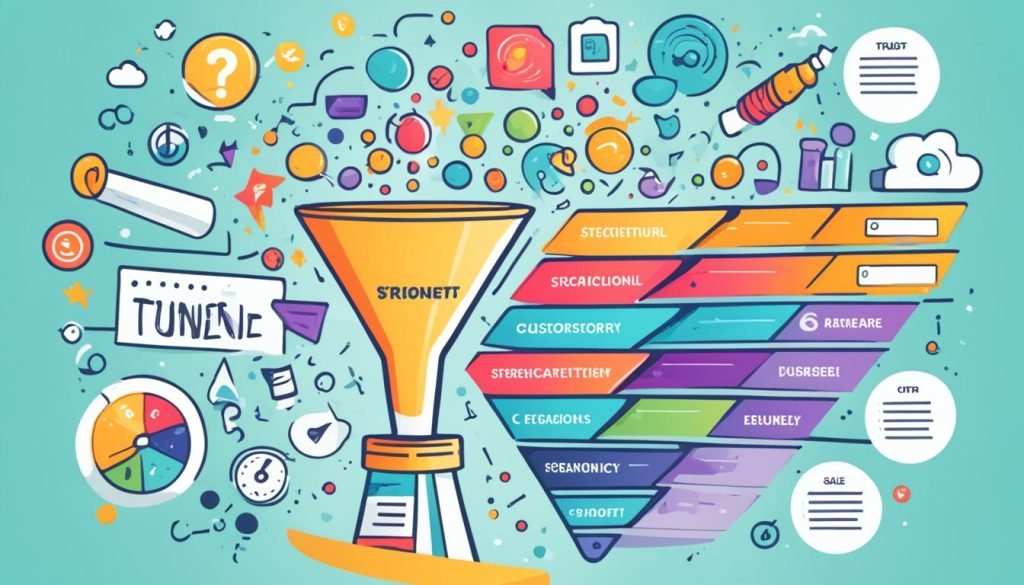Have you ever walked into a store with no plan to buy, but then left with a bag full of stuff? Or maybe you’ve been scrolling through social media, and an ad caught your eye? We often make buys or click on things without understanding why.
There’s a smart technique behind this. Businesses understand how to lead us to buy something. This is known as the psychology behind successful sales funnels.
It’s crucial for companies to know this science. They can make their marketing work better, improve how we feel online, and increase sales. By knowing about consumer behaviour, how we think, and our choices, they make steps that lead us through to buying.
Now, we’ll look deeper into the engaging area of sales psychology. We aim to show you how understanding this can change your online marketing for the better.
Key Takeaways:
- Understanding the psychology behind sales funnels is crucial for optimizing marketing strategies and enhancing user experiences.
- Consumer behavior, cognitive psychology, and the decision-making process play key roles in the effectiveness of sales funnels.
- By leveraging concepts such as scarcity, social proof, and commitment and consistency, businesses can influence customer behavior and drive conversions.
- Creating an effective sales funnel involves guiding customers through stages of awareness, interest, consideration, and purchase.
- Continuous optimization and testing are essential for maximizing the benefits of sales funnels and achieving long-term success.
What is a Sales Funnel?
A sales funnel is like a map for customers, showing them the way from finding out about a product to buying it. This tool is made up of four main parts: awareness, interest, consideration, and purchase. It helps companies see how people learn about their products and make decisions to buy them. By understanding these steps, businesses can make their marketing more focused on what the customer needs at each stage.
At the start is the awareness phase, where people first hear about a brand. It could be through ads, social media, or posts that catch their eye. The main aim here is to get the customer’s attention and let them know what the company offers.
Once customers are aware, they move to interest. Here, they want to learn more, so it’s a good time for companies to share interesting content. They can send them emails or offer special downloads to start building a connection.
Did You Know? It usually takes 6-8 times of reaching out to a customer to really get their attention.
In the third stage, consideration, customers start looking closely at what’s on offer. This is when businesses can step in with personalised advice, product demos, or what others have said (like reviews or testimonials). The idea is to help customers choose their brand over the competition.
At last, we reach the purchase stage. Customers are ready to buy. Here, companies can use offers or discounts to nudge them towards closing the deal. The main focus now is to make buying as easy and pleasant as possible.
Understanding the sales funnel helps businesses plan their marketing better. They can aim their messages more accurately, making it more likely people will buy. This can turn one sale into many, by creating loyal customers.
| Stage | Description |
|---|---|
| Awareness | Customers become aware of a company or product. |
| Interest | Customers actively seek more information. |
| Consideration | Customers evaluate options and make comparisons. |
| Purchase | Customers make the final decision and complete the purchase. |
The Psychology Behind a Sales Funnel
The success of a sales funnel comes from knowing how people decide to buy. Using strategies like showing something is rare, the idea that we’ve already put a lot into something, and getting people to agree to small things can help lead customers towards buying from you.
Scarcity: Creating a Sense of Urgency
Scarcity makes some people want things more. If something is limited or only available for a short time, people feel an urge to get it. By saying there’s only a few left or the offer ends soon, businesses can push customers to buy now.
The Sunk Cost Fallacy: Continuing the Investment
The sunk cost fallacy makes us keep going with a purchase because we’ve already spent so much on it. Through the funnel, showing the product’s worth and benefits reminds customers of their initial investment. And it leads them to think that if they don’t buy, that first investment was for nothing.
Commitment and Consistency: Increasing Follow-through
Consistency is key in the sales process. By encouraging small commitments along the funnel, businesses can increase the likelihood of a larger commitment, such as making a purchase.
People like to be true to what they say they’ll do, especially if it matches their beliefs. Encouraging small steps, like joining a mailing list or answering a survey, can make them more likely to buy later. These steps build a sense of trust and push towards a bigger commitment, like a purchase.
Knowing the workings behind a sales funnel lets businesses fine-tune their approach. By focusing on creating urgency, reminding customers of their prior investments, and insinuating small commitments, they can guide people to purchase more. This approach can boost sales and overall revenue significantly.
Stay tuned for more on how sales funnels operate and the steps involved.
How a Sales Funnel Works
A sales funnel is like a roadmap. It guides potential customers from knowing nothing to making a purchase. For businesses, understanding the sales funnel is key. It helps engage with people and turn them into buyers.
1. Awareness: This is the start. You need folks to know about your company or products. Social media, content marketing, and ads are key here. The aim is to get people interested in what you offer.
2. Interest: Once aware, you’ve got to get people interested. Share more details about your products or services now. Use things like blogs, videos, and guides to catch their eye.
3. Consideration: Next, they’re thinking about buying. They’re checking out what you have against others. Show what makes you special. Share stories, show success, and offer help personally.
4. Purchase: After thinking it through, they’re ready to buy. Make this step easy. Take away any hassle to seal the deal.
“A well-optimized sales funnel can guide potential customers smoothly through each stage, maximizing the chances of converting them into paying customers.”
Knowing and acting on the sales funnel helps businesses. They can lead people on, step-by-step, to buy. It’s also key to keep checking and fixing the funnel. This way, you make sure people have a great journey to buying from you.
| Stage | Description |
|---|---|
| Awareness | Generate awareness of your brand or product |
| Interest | Capture potential customers’ interest through engaging content |
| Consideration | Provide detailed information and reasons to choose your brand |
| Purchase | Facilitate a seamless buying process |
The Benefits of Using a Sales Funnel
Using a sales funnel in your business can lead to great success. It helps you reach your marketing and sales goals. Let’s dive into how a sales funnel can be a game-changer for your business.
Focus Your Marketing Efforts:
A sales funnel helps you concentrate your marketing on those likely to convert. By knowing each funnel stage, you can create focused strategies. This makes your campaigns more effective for connecting with your audience.
Qualify Leads:
Assess lead interest and engagement through a sales funnel. It helps you find the leads most likely to buy. Then, you can make sure your sales team focuses on converting the best leads first.
Close More Deals:
A sales funnel guides leads through the buying process. It addresses their concerns and gives them what they need to decide. This personal touch makes them more likely to buy, improving your conversion rates.
Increase Average Order Value:
With an optimised sales funnel, you can increase your average order value. You do this by offering products or services that go well with what they’re buying. This often leads to customers spending more, which boosts your revenue.
Improve Customer Lifetime Value:
A sales funnel helps in building customer relationships and increasing their lifetime value. By nurturing leads and providing great experiences, you get loyal customers. This boosts revenue per customer and brings positive reviews and referrals.
Using a sales funnel has many benefits. It focuses marketing, qualifies leads, and boosts deal closures. Also, it raises order values and customer lifetime values. It is crucial for enhancing your sales process and earning more.
Now you see how a sales funnel can do wonders for your business. Let’s next look into the science behind why it’s so effective.
The Benefits of Using a Sales Funnel – At a Glance
| Benefits | Description |
|---|---|
| Focus Marketing Efforts | Target the most promising leads and optimize marketing strategies. |
| Qualify Leads | Evaluate lead engagement and prioritize sales efforts. |
| Close More Deals | Guide leads through the buying process and improve conversion rates. |
| Increase Average Order Value | Upsell and cross-sell to boost the value of each order. |
| Improve Customer Lifetime Value | Nurture relationships and encourage repeat purchases. |

The Science Behind a Sales Funnel
To make their marketing better and increase sales, businesses need to understand sales funnels. They use tricks from psychology, like making things seem rare or showing that other people like a product, to change how we shop.
Scarcity means making something seem rare or special. This can be done by showing that there’s only a little left, that it’s available for a short time, or by offering special deals. It pushes people to buy now out of fear they might miss their chance.
“When customers think something is rare, they can feel like they must buy it now so they don’t miss out.”
Social proof is about looking to others for guidance. If people see that a lot of others like something, they’re more likely to believe it’s good and safe to buy. This is why showing happy customer testimonials and good reviews is so powerful.
“Seeing that others enjoyed a product makes people trust it more and want to buy it.”
The sunk cost fallacy makes us stick with things we’ve already put time or money into, even if it’s not the best choice. Sales funnels use this to their advantage, offering small, easy-to-start choices that make us want to carry on.
“After starting the buying process, customers want to keep going. They don’t want to feel like they wasted their first effort.”
Businesses use these psychological tricks to lead us through the buying process. These tricks target our hidden preferences and biases, helping make the final buy decision more likely.
Applying the Science in Your Sales Funnel Strategy
To make the most of sales funnel science in your marketing, keep these in mind:
- Make things seem scarce to push people to buy now.
- Show that others like your product through good reviews and testimonials.
- Give easy, low-cost ways to start buying, encouraging people to continue.
By using these strategies, you can make your sales funnel work better. It’ll help attract more customers, increase sales, and boost your marketing success.
How to Create an Effective Sales Funnel
Creating a top-notch sales funnel is vital for turning potential customers into loyal ones. Start by learning what your audience needs. Do thorough market research to pinpoint how your product or service can help them.
Now, put effort into finding leads. This means using ways to catch people’s interest and get their contact details. Making your site better, using ads, and sharing useful stuff like eBooks or webinars will attract leads.
After collecting leads, it’s time to nurture them. Talk to your leads in ways that make them trust you. Provide content that’s relevant to them, addresses their problems, and suggests solutions. This makes them more likely to buy from you.
It’s crucial to talk to each lead in a way that suits them. Personalising your communication is the best way to win their trust.
Always keep testing and analysing your sales funnel. Check on things like how many people turn into customers, and how engaged they are. This data helps you tweak your funnel design. Try new things to see what works best with your audience.
Optimising your sales funnel involves:
- Creating compelling landing pages that drive conversions
- Implementing email marketing campaigns that deliver personalised content
- Utilising social media platforms to engage with your audience
- Offering valuable incentives to encourage conversion, like limited time discounts or exclusive offers
Always work on making your sales funnel better. By making regular improvements, you’ll boost the number of sales. Remember, a good sales funnel keeps changing as you learn more about your customers.

Putting a great sales funnel in place is vital for your business’s growth. By offering a journey that feels just right for your audience, you can make more sales and earn more money.
Tips for Optimizing Your Sales Funnel
Optimizing your sales funnel boosts conversions and revenue. Continuously refine strategies and measure metrics. This way, you can make your sales funnel more effective and earn more money. Follow these tips to streamline your sales funnel:
- Test and Tweak: Always test parts of your sales process, like landing pages and call-to-actions. Look at the numbers, and make changes based on what the data says. This will improve how well your funnel works.
- Create Personalized Content: Match your content and messages to what your audience needs and likes. Giving personalised experiences will help you gain trust and connect with your potential customers.
- Implement Targeted Email Campaigns: Send emails geared towards different parts of your audience. By sending the right info and deals to the right people, you can boost engagement and clicks.
- Track Key Metrics: Keep an eye on important numbers like who’s converting and who’s leaving. Use this info to spot where you can get better and to make smart choices.
“Continuous optimization is the key to a successful sales funnel.”
Improving your sales funnel is a constant effort. With these tips and by always refining your approach, you can upgrade its performance. This will bring in more leads and drive up your conversions.
| Key Metrics to Track | Definition |
|---|---|
| Conversion Rate | The percentage of visitors who complete a desired action, such as making a purchase or filling out a form. |
| Bounce Rate | The percentage of visitors who leave your website without taking any action or navigating to other pages. |
| Average Order Value | The average amount of money spent by a customer in a single transaction. |
| Customer Lifetime Value | The predicted net profit generated by a customer throughout their entire relationship with your business. |
Common Mistakes to Avoid When Using a Sales Funnel
Setting up a sales funnel can really boost your marketing. Yet, many businesses slip up on it. Knowing these mistakes can smooth out your customer journey.
1. Lack of Clear Roadmap
Not having a smooth customer journey mapped out can hurt. If your customers don’t know what’s next, they might leave. This leads to fewer sales.
It’s key to show every step from discovery to buying clearly. This helps both your team understand and your customers enjoy the process.
2. Not Testing and Tweaking
Failing to refine your sales funnel is a big blunder. You must experiment with what works and what doesn’t. Only then can you get more sales.
Keep an eye on how well the funnel’s doing with stats like conversions. This helps you fine-tune your approach for better results.
3. Generic or Irrelevant Content
Using content that doesn’t speak to your audience is a big mistake. Your content must be spot on for your potential customers. It should help them, showing why your product is the right choice.
The key is relevant content that draws your leads closer to buying. Crafting content that resonates can win you trust and boost sales.
“Your sales funnel should be a well-crafted journey that guides your customers towards making a purchase decision.”
Avoid these pitfalls, and you’ll design a smoother path for customers. This can ramp up your sales and profits.
| Common Mistakes | Impact |
|---|---|
| Lack of clear roadmap | Confusion and disengagement, lower conversion rates |
| Not testing and tweaking | Poor funnel performance, missed optimization opportunities |
| Generic or irrelevant content | Lack of engagement, decreased trust and credibility |
The Role of Lead Magnets in Sales Funnel Optimization
Lead magnets are crucial in making sales funnels work better. They are valuable items or information that make people give you their contact details. This helps companies start talking directly to customers and guide them through the buying process.
Lead magnets come in many shapes, like e-books, whitepapers, or even discounts. The important thing is that it should be something your audience values. In return, they share their details with you.
When you have someone’s contact info, you can start a caring, personal conversation. You get to know what they are interested in and offer them advice. This helps in making them feel ready to buy from you.
This process is key in building trust. By sharing valuable information, you show that you know your stuff. As a result, people start to believe in your brand more. They are then more likely to buy from you.
Lead magnets must fit the right audience and their stage in the buying process. Make sure what you offer solves their problems. This shows them the value you bring to them.
But remember, a good lead magnet is just the start. You also need a clear plan on what to do next. Keep in touch with these leads. Send them more info and offers that they are likely to find interesting.
Example of a Lead Magnet in Action:
Imagine a company that offers a free e-book on sales funnel tips. Their website invites visitors to sign up to get the free e-book. It quickly becomes a way to get their contact info and show value.
After signing up, these visitors get more emails on the topic. This helps keep them interested and slowly guides them to possibly buying. It all starts with that lead magnet.
This is how lead magnets can really help a business. They can make the sales process smoother. They help get valuable visitor info, show them something valuable, and build trust step by step.
| Benefits of Lead Magnets | Role in Sales Funnel Optimization |
|---|---|
| 1. Capturing contact information | 1. Establishing direct communication |
| 2. Offering valuable incentives | 2. Nurturing leads through the funnel |
| 3. Building trust and credibility | 3. Increasing chances of conversion |
| 4. Tailoring content to audience needs | 4. Guiding potential customers towards purchase |
Crafting Effective Landing Pages for Your Sales Funnel
Optimising your sales funnel’s landing page is key for success. Landing page optimization helps catch potential customers’ eyes. It encourages them to buy. Let’s look at making landing pages work by highlighting a great headline, a clear call-to-action, and mobile-friendly design.
The Power of a Compelling Headline
Your landing page’s headline is the first thing visitors see. It’s your chance to hook them. Your headline must be crystal clear and interesting. It should grab their attention and explain what makes your product or service special.
For example:
“Unlock Your Potential with Our Revolutionary Fitness Program”
This headline shows the programme’s unique benefits and why it’s special.
The Importance of a Strong Call-to-Action
A clear Call-to-Action (CTA) tells visitors what to do next. It might be to buy something, sign up for a newsletter, or trial a product. The CTA should be impossible to miss. It should spur people to act right away.
For example:
“Start your journey to a healthier lifestyle today! Get 50% off on your first month.”
This CTA mixes urgency (start now) with a great discount (50% off) to push visitors to sign up quickly.
Remember, your CTA must stand out. You can make it bold or use different colours. This ensures visitors know what to do next.
The Need for Mobile Optimization
Today, everyone uses mobiles. So, your landing page must look good on them. A mobile-friendly landing page is designed to fit any screen. This makes it easy to read and use.
To make your page mobile-ready:
- Simplify the layout and add big, easy-to-click buttons.
- Make sure the page loads quickly.
- Choose images and graphics that look good on small screens.
By focusing on mobile, you won’t miss customers using phones or tablets. This boosts your sales chances.
| Landing Page Optimization Checklist |
|---|
| ✓ Craft a compelling headline that captures attention |
| ✓ Create a strong call-to-action that guides visitors towards conversion |
| ✓ Optimize your landing page for mobile devices |
Nurturing Your Leads: The Importance of Email Marketing in Sales Funnels
Email marketing is key for guiding leads on their journey through the sales funnel. By sending personalised emails and useful content, you can connect with potential customers.
It’s crucial to make your emails personal. This means crafting each message to fit the needs and likes of your leads. By dividing your email list into different groups, you can send content that really speaks to them.
Sending valuable content helps to win trust and be seen as a reliable source. Giving out great articles, special deals, or learning materials makes your brand stand out. It keeps leads interested and lets them know you’re an expert in your field.
Email marketing helps your leads at every step of the sales funnel. It starts by introducing your brand and go on to build interest and close sales. Done right, it’s a powerful way to drive your leads towards making a purchase.
Make sure you’re using email marketing to its fullest. It’s an important part of your sales strategy. Use it well to nurture your leads and see better results in your sales efforts.





